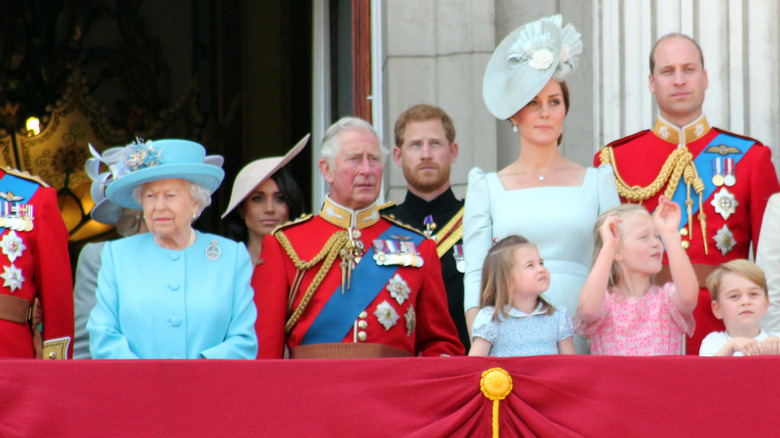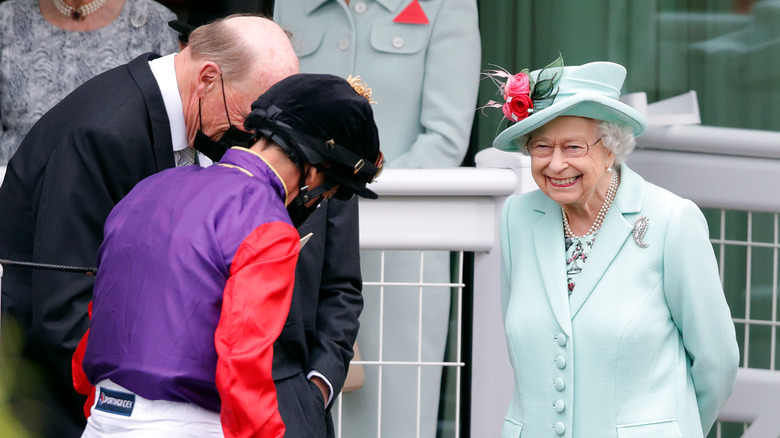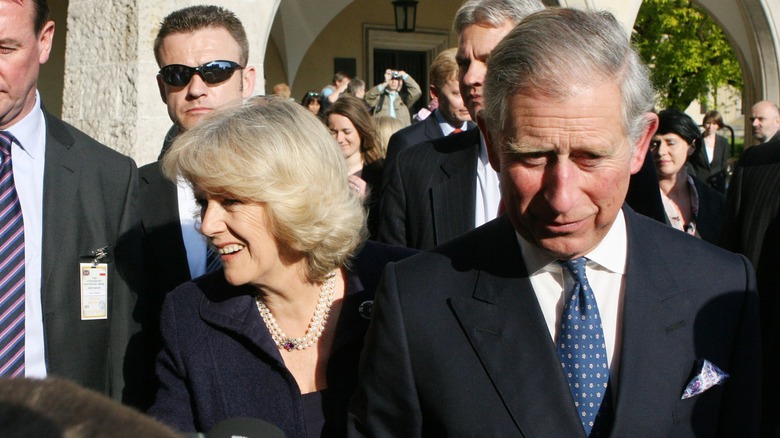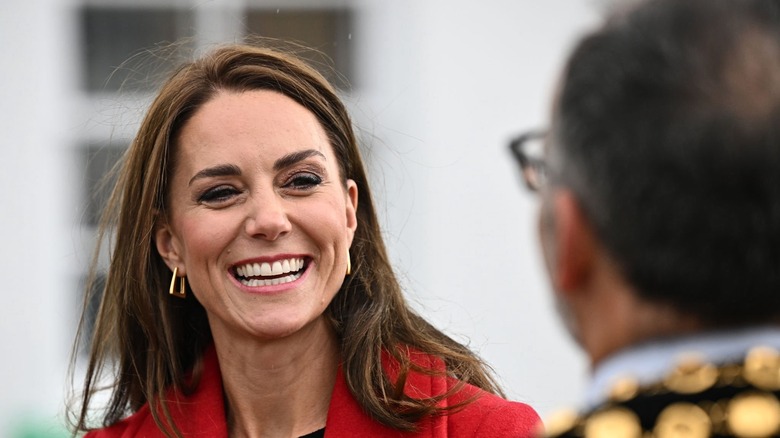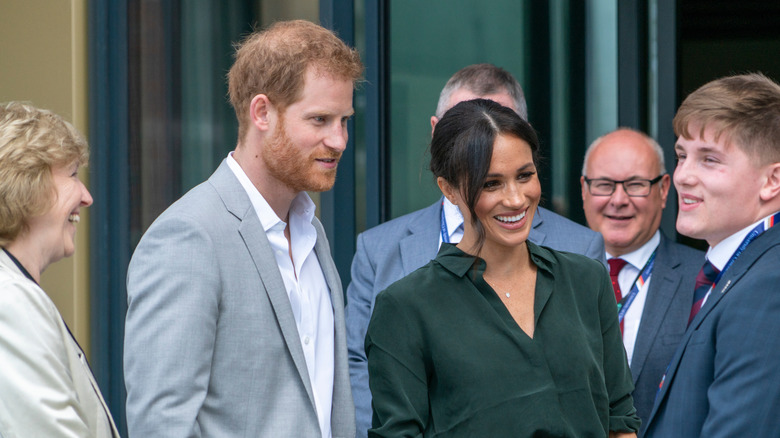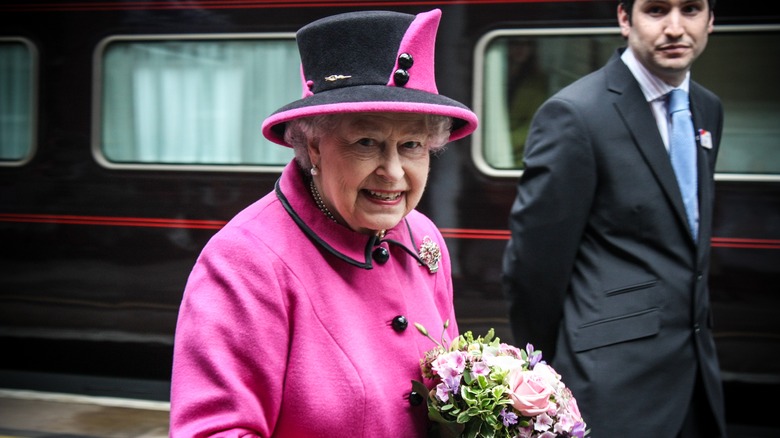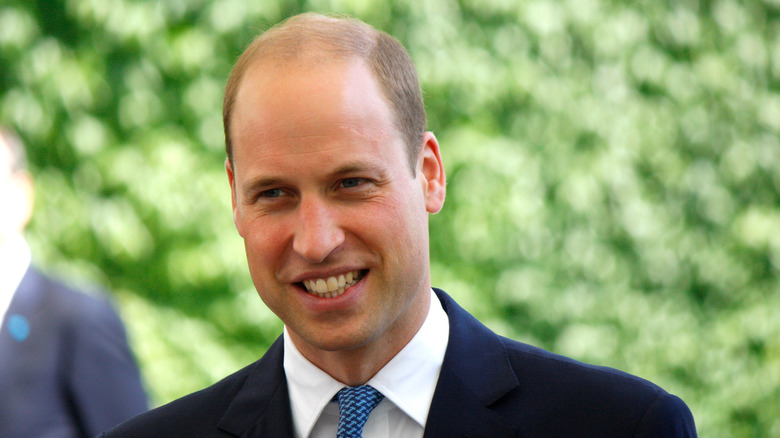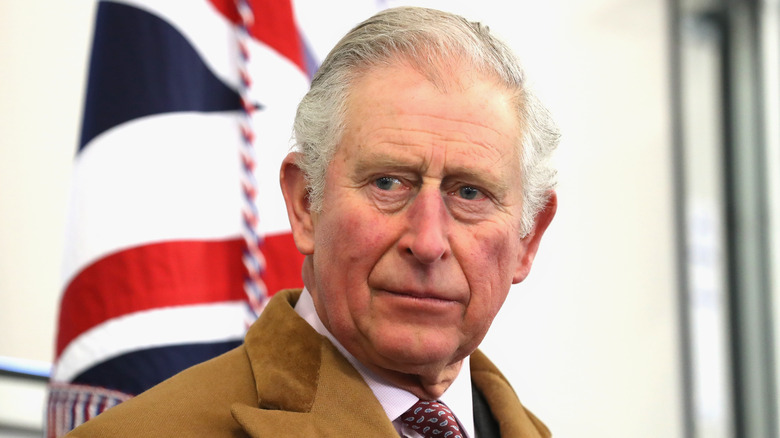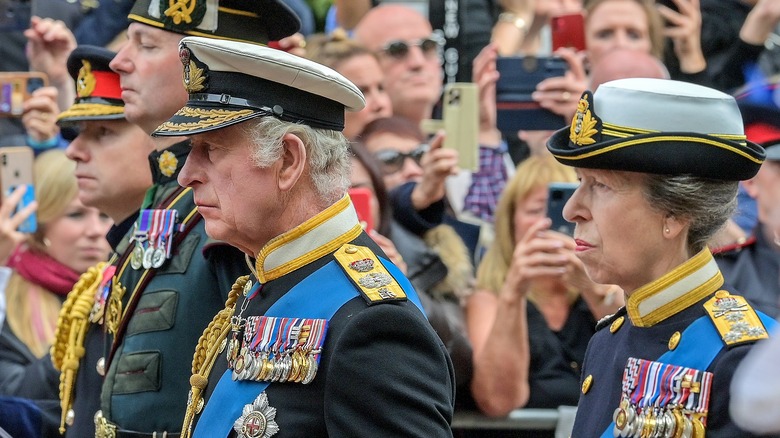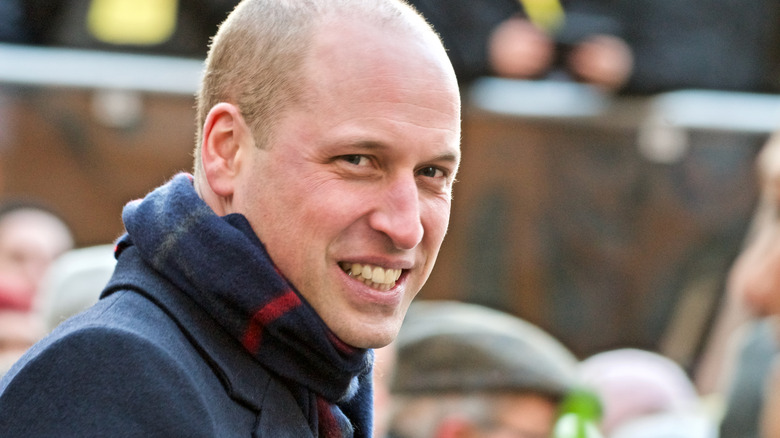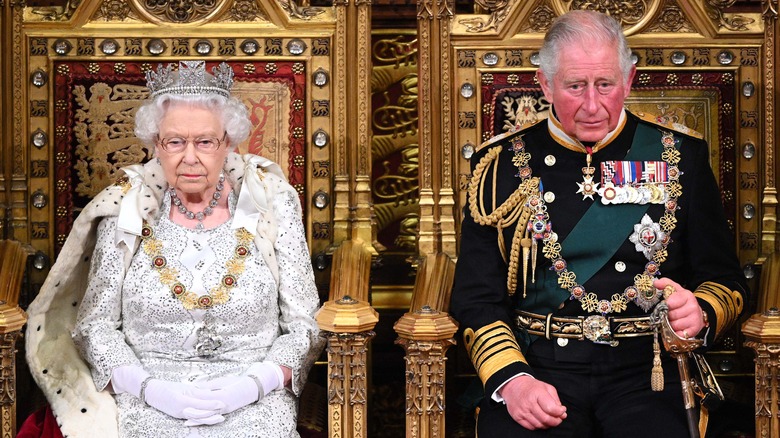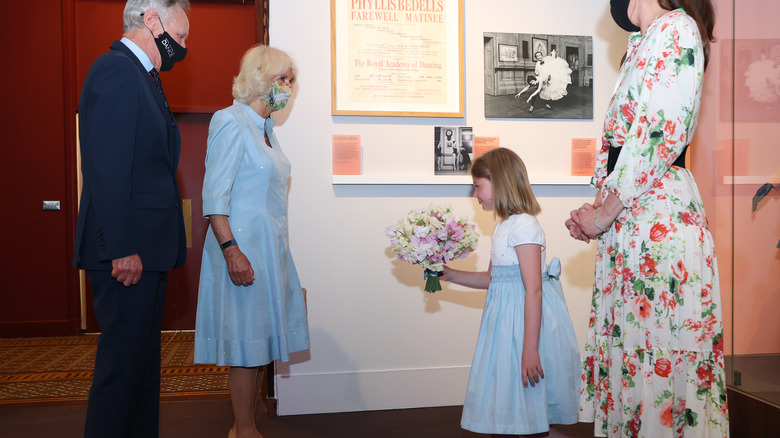All The Rules Surrounding Royal Bows And Curtsies
Even those with nothing more than a passing familiarity of the royal family assume that when you meet any of them, you must bow or curtsy. After all, isn't that what one has always done in the presence of kings and queens throughout history? Not always, as it turns out. It's true that in some ancient cultures, gestures such as bowing were a standard way of acknowledging another person's superior social rank. But in others, such as the culture of ancient Greece, bowing was considered a gesture of reverence to gods, so bowing to a fellow human — no matter how high his or her rank — was seen as inappropriate.
Still, bowing has long been a standard gesture in the presence of the British royals. By tradition, the royals have kept a firm physical (and social) distance from their subjects, and the few interactions royals had with commoners tended to be formal. In recent years, however, this has started to change as new, less-formal generations of royals — starting with Princess Diana — came into prominence and began to embrace a more accessible and casual style of relating to the general public. Today, some royals are likely to engage in hugs and handshakes along with bows and curtsies. This, however, has only made things more complicated. Touchy-feely as some younger royals can be, old traditions die hard, and bowing and curtsying are still very much part of the mix in royal circles. And the rules involved can be arcane and complicated.
Officially, there are no rules for bowing to the royal family
If you take the royal family's official messaging at face value, there's no need to worry about bowing or curtsying to any of them. "There are no obligatory codes of behaviour when meeting The Queen or a member of the Royal Family, but many people wish to observe the traditional forms," the royal household's website reassures us. These traditional forms include bowing and curtsying, of course, but the website emphasizes that handshakes are also appropriate.
Despite this, most people assume that bowing and curtsying are standard and expected. This seems like a reasonable assumption, given that members of the royal family are even expected to bow to each other, as Meghan Markle famously discovered before her first meeting with Queen Elizabeth II. And even Prince Harry, who was born and raised observing royal rituals, realized the absurdity of these customs. "How do you explain that you bow to your grandmother and that you would need to curtsy? Especially to an American. That's weird," he said in the documentary "Harry and Meghan" (per People). So of course the royal family's claim that they don't expect any of us to bow to them seems a bit odd – if they expect bows even from each other, wouldn't it be weird for them to settle for handshakes from us?
Everyone bows to the monarch – including his children
The central principle behind most royal rules involving bowing is that those of lower rank bow or curtsy to those of higher rank. Because the reigning monarch outranks everyone, by tradition, members of the royal family are expected to bow or curtsy to him or her. This, of course, leads to the absurd (to American sensibilities) scenario of royal family members being required to bow or curtsy to a sibling, parent, or grandparent.
And royal-watchers have captured plentiful documentation of royal family members doing just that. One photo shows Prince William and Princess Catherine offering Queen Elizabeth II a brief bow and curtsy. And on their wedding day, Prince William's parents, then-Prince Charles and Princess Diana, stopped to bow and curtsy to the queen as they passed her on the way to the altar. And now that King Charles III has ascended to the throne, Prince William is required to bow to both him and his stepmother, Camilla, Queen Consort (and has been seen doing just that, at least in public). But at least he's managed to avoid the cringy obligation to address his own father as "Your Majesty." "The queen and Prince Philip were Ma and Pa to their children; whatever William and Harry called Charles and Camilla yesterday, they will call them that today," Majesty managing editor Joe Little explained to Page Six.
Royal children are expected to start bowing at age 5
Nobody expects little kids to have perfect manners. The really little ones obviously lack the physical coordination, language skills, and self-control to conduct themselves gracefully, and the often-arbitrary rules and social expectations held by adults take time for older kids to learn and understand. And while young children of high-ranking royals must get used to being in the public eye at an early age, they're still understood to be little kids, with all the limitations that implies: Nobody expects bows or curtsies from toddlers barely able to walk.
Still, because of their visibility, royal children are expected to get with the program fairly quickly — including mastering the skills of bowing and curtsying at appropriate times. As royal historian Marlene Eilers Koenig told Hello! (via Women's Health), young royals are expected to start bowing and curtsying in public by age 5. However, they're not expected to master all the rules of who bows to whom in one fell swoop. "The only person they will curtsy or bow to is the sovereign," she explained. But in the days following Prince George's fifth birthday, observers watched in vain for him to take his first bow to the queen. Koenig wasn't worried, hypothesizing that he had most likely been practicing the new skill privately at home with his parents.
Princesses by marriage must (sometimes) curtsy to blood princesses
One of the most fraught parts of getting married can be navigating the personal politics of your spouse's extended family. The best-case scenario is marrying into a chill family of live-and-let-live types who figure if you're good enough for their relative, you're good enough for them. An especially challenging scenario, as Meghan Markle learned the hard way, is marrying into Britain's royal family, with its decades of bad blood and a slew of baffling ancient customs and rules that need to be followed.
Among these customs are the complex rules of who bows to whom in the royal family. One of the more obscure rules states that princesses by marriage — such as Markle and her sister-in-law, Princess Catherine — are ranked below princesses born into the royal family, such as Prince Andrew's daughters Princess Beatrice and Princess Eugenie. Thus, princesses by marriage are obliged to curtsy to princesses by birth. So technically, Princess Catherine is required by tradition to curtsy to her own children, a rule she almost certainly ignores. But according to Debrett's, another twist makes this odd rule seem even more arbitrary. "Protocol dictates that when the Princess of Wales and Duchess of Sussex are not accompanied by their husbands, Princesses of the Royal Blood, such as Princess Beatrice and Eugenie, rank above them," Debrett's explained. "However, when the Duchesses are accompanied by their husbands, the roles are reversed [and] the duchesses outrank the princesses."
Family members with the title HRH do not have to bow to each other
If the general royal protocol is that royals of lower rank must bow or curtsy to those of higher rank, it follows that royals of the same rank will not have to bow to each other. But like all things related to royal etiquette, even this common-sense rule isn't as simple as it seems. The definition of what it means for royals to be of equal rank has shifted over the years, with some of the changes occurring fairly recently.
For instance, the standard rule is that royals who take the honorific HRH need not bow or curtsy to each other (with the possible exception of those who acquired the title by marriage, who rank below those who were born to it). However, the rules determining who gets to be called HRH have changed over time. In 1917, King George V restricted use of the honorific to children of the sovereign, the children of sons of the sovereign, and the eldest son of the Prince of Wales' eldest son (per Town & Country). Nearly 100 years later, in 2012, Queen Elizabeth II changed the rules to allow all children of the Prince of Wales' eldest son to take the HRH designation, not just sons. In practice, this meant that Prince William's daughter, Princess Charlotte, would hold the same rank as her brothers, and thankfully will not be required to curtsy to them.
Family members meeting the monarch multiple times in a day only bow at the first meeting
The easiest of the rules regarding royal bowing and curtsying is that everyone must bow to the monarch. Its simplicity and symbolic importance are probably why it's the first rule of bowing and curtsying that royal children are required to master. But strange as it may seem to be required to bow to one's parent or grandparent, it would be downright absurd to have to do so every time the two of you showed up in the same room, especially if you were spending a lot of time together traveling or working on a project.
And tradition-bound as they are, members of the royal family are practical enough to realize this. Close observers of the family have spotted instances of royals greeting the monarch with a quick nod or hug instead of a bow, and royal watchers confirm there's a legitimate reason for this. "You bow or curtsy the first time you see the sovereign and then again when you leave," royal expert Marlene Eilers Koenig told Hello! (via Travel and Leisure). "At church, we saw the Cambridges and Prince Harry and Meghan curtsy and bow when the queen arrived and left. Other royals including Charles did not because they had come from Sandringham and had already seen the queen."
Prince William and Princess Catherine plan to stop public bowing when they take the reins
Pomp and ceremony (and a certain amount of mystique) have always been part of the royal family's image. But contrary to popular belief, the rules around the royal family and its relationship with the general public are not carved in stone. While some members of the royal family prefer to adhere to accepted tradition, others — such as Princess Diana — chose to forge their own path and cultivate a warmer, less-formal approach to interacting with the public.
And the next generation of royals is planning to continue modernizing the monarchy. Sources close to the royal family have said that Prince William and Princess Catherine intend to foster a more approachable and less-stuffy royal culture when it's their turn to take the throne. This desire for change was reinforced by their ill-received trip to the Caribbean, where the formality of the royal entourage came off as arrogant and out of touch. "So now it's more 'Wills and Kate' instead of the Duke and Duchess of Cambridge ... 'Just call me Wills' type of thing," a source close to the couple told the Mirror. "They want to try to avoid the bows and curtsies in public, be more approachable, less formal, less stuffy, and break away with a lot of the tradition and focus on a modern monarchy."
The monarch is not required to bow to anyone
Apart from very young royal children, pretty much everyone in the royal family is obliged to bow to more senior relatives on a regular basis, with only one member being conspicuously free from this requirement: the monarch. Spouses of the monarch also enjoy this privilege: Since King Charles III ascended to the throne — a shift that promoted his wife, Princess Camilla, to Queen Consort Camilla — she too inherited the right not to curtsy to anyone. With her newly elevated rank, however, now even high-ranking royals such as the Prince of Wales are required to bow or curtsy to her.
But even though the monarch isn't required to bow or curtsy to anyone, some have been spotted breaking with this tradition. Following Princess Diana's death in 1997, for instance, the royal family was reeling not just from her loss but the public's hostile reaction to their traditionally low-key and reserved reaction to it, which struck them as callous and uncaring. Queen Elizabeth II, sensing the need to salvage the situation and the royal family's image, made a public eulogy honoring Princess Diana and appeared with the rest of the family at a number of memorial events. At one point, she was seen dipping her head in a bow at Princess Diana's coffin — not a required or expected gesture from a royal of her stature, but a genuine show of respect.
Royal family members bow to each other even in private
For most people who don't run in royal circles, bowing and curtsying are so far outside our personal experience we assume they're just public gestures performed for purely ceremonial purposes. This was the case for Meghan Markle, who was flabbergasted to learn she'd be required to curtsy upon meeting her future grandmother-in-law in a private gathering at her home. "I thought genuinely that's what happens outside, that was part of the fanfare," she told Oprah Winfrey (via Cosmopolitan). "I didn't think that's what happens inside."
But for members of the royal family, bowing and curtsying are as much a part of everyday life as shaking hands and answering emails, and the gestures happen even at home and when the cameras aren't rolling. All family members bow or curtsy to the king during their first meeting of the day (they can forgo these gestures if they run into each other again later in the day), and even in private, royals routinely bow or curtsy to higher-ranking relatives.
Foreign dignitaries and visitors are not required to bow to royals
A big part of the royal family's duties is meeting with foreign visitors and dignitaries, both to promote Britain's own interests and build constructive relationships with other countries and their leaders. And even high-profile visitors to the royal family know they will be required to observe some strict, traditional rules of protocol. Fortunately, the royal household recognizes that its expected codes of behavior are far from obvious, especially for foreign visitors, so royal retainers make a point of instructing guests in advance about what to expect and how to dress and behave.
But while there are certain strict rules that visitors must observe when meeting the royal family (for instance, promptness is a must, one does not speak to royal family members until spoken to, and it's considered bad form to leave an event before the royal family has left), one thing foreign guests won't have to worry about is bowing or curtsying. The gesture is traditionally seen as a mark of respect to the crown, not necessarily the person wearing it, so guests who are not British subjects are not expected to bow or curtsy, although some choose to do so. For those who choose not to, a polite handshake will do.
A 2005 document officially codified who bows to whom in the royal family
One of the many things that complicate the rules of who bows or curtsies to whom is that the relative ranks of royal family members are fluid — they shift as family members are born, die, or marry into the family, and keeping track of it all can get pretty confusing pretty fast. For a long time, relative ranks in the family were determined by longtime (but unofficial) tradition.
To avoid future confusion, in 2005, the queen's private secretary drafted an official document, Precedence of the Royal Family To Be Observed at Court, which explicitly laid out the rankings of family members and the rationale behind the rankings. (The document was explicitly drafted to ascertain which family members were obliged to bow or curtsy to Princess Camilla, who had just married into the family.) According to the National News, it was updated in 2012 to clarify whom Princess Catherine was required to curtsy to after she married into the family.
If you choose to bow or curtsy to a royal, here's the right way to do it
Traditionally, royal families across cultures demanded dramatic displays of respect from their subjects, visitors, and courtiers. For instance, a longtime tradition of the British royal family — recently abandoned for reasons of safety — was the requirement that courtiers leaving the presence of the monarch do so by walking backwards out of the room to avoid the disrespectful gesture of turning their backs on the king or queen. Today, at least officially, the royal family has loosened such expectations. It even states on its official website that bows and curtsies are not required when meeting royal family members, and brief handshakes are perfectly appropriate.
But many people feel more comfortable observing the old tradition — or perhaps enjoy the rare opportunity to actually do so. If you do choose to bow or curtsy in the presence of a royal, the key thing to remember is not to overdo it. Nobody is expecting you to scrap your head against the floor or even do a deep waist bend. For men, the royal household advises, the proper gesture is "a neck bow (from the head only)," while the appropriate gesture for a woman is "a small curtsy." And be aware that overdoing the gesture can be seen as disrespectful. Meghan Markle's exaggerated curtsy in the documentary "Harry and Meghan," for instance, stirred controversy among viewers, some of whom thought she was disrespecting the royal institution, while her defenders argued that she was just mocking her own unfamiliarity with royal customs.
